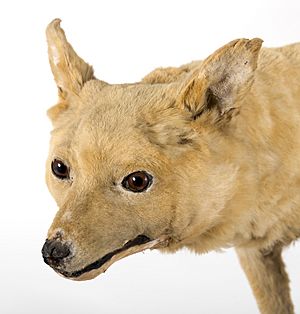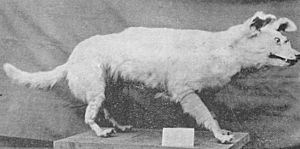Kurī facts for kids
 |
|
| Origin | New Zealand |
|---|---|
| Breed status | Extinct |
| Domestic dog (Canis lupus familiaris) | |

The Kurī was a special type of dog from New Zealand. Its name, Kurī, comes from the Māori language. These dogs were brought to New Zealand by the Māori people's ancestors. This happened a long time ago, around the 13th century AD, when they traveled from East Polynesia. An old Māori story says that the first dog was created by the demigod Māui.
What Did the Kurī Look Like?
Kurī dogs had bushy tails and short legs. They also had strong shoulders. Their fur came in different colors. These included yellowish-brown, black, white, or even spotted. Like other dogs from Polynesia, Kurī would howl instead of barking. The Māori word for their howl was auau.
How Were Kurī Used?
Kurī dogs were important to the Māori people. They were sometimes used as a source of food. The British explorer James Cook tried Kurī meat during his trip in 1769. He said it tasted almost as good as lamb.
Kurī were also helpful for hunting birds. Besides that, Māori used the dogs' skins and fur. They made special dog-skin cloaks called kahu kurī. They also used the fur for belts, decorations for weapons, and poi (balls used in performance art).
Why Did the Kurī Disappear?
When James Cook first visited New Zealand in 1769, Kurī dogs were common. However, the Kurī breed became extinct in New Zealand by the 1860s. This happened after European settlers arrived. The Kurī dogs could not survive because they bred with the European dogs. The last known Kurī specimens were a female dog and her pup. Their remains are now kept at the Museum of New Zealand Te Papa Tongarewa.
See also
 In Spanish: Kurī para niños
In Spanish: Kurī para niños

